Supporting Use of Medication in a Social Care Setting Report
VerifiedAdded on 2020/06/04
|8
|2135
|420
Report
AI Summary
This report comprehensively examines the use of medication in social care settings. It begins with an introduction to different routes of medication administration and the importance of mindfulness. The report then delves into the legal and policy frameworks governing medication handling, including the Misuse of Drugs Act and the Health Act 2006. It outlines the roles and responsibilities of healthcare professionals involved, such as practitioners and prescribers, and details how to access patient medication information. The report further discusses the administration of medication, various forms of medication, and equipment that can assist in the process. It highlights the data that must be recorded, safe storage practices, and the proper disposal of unwanted medications. The conclusion emphasizes the importance of managing medications to reduce misuse and ensure patient safety, referencing key legislation and best practices for healthcare organizations.
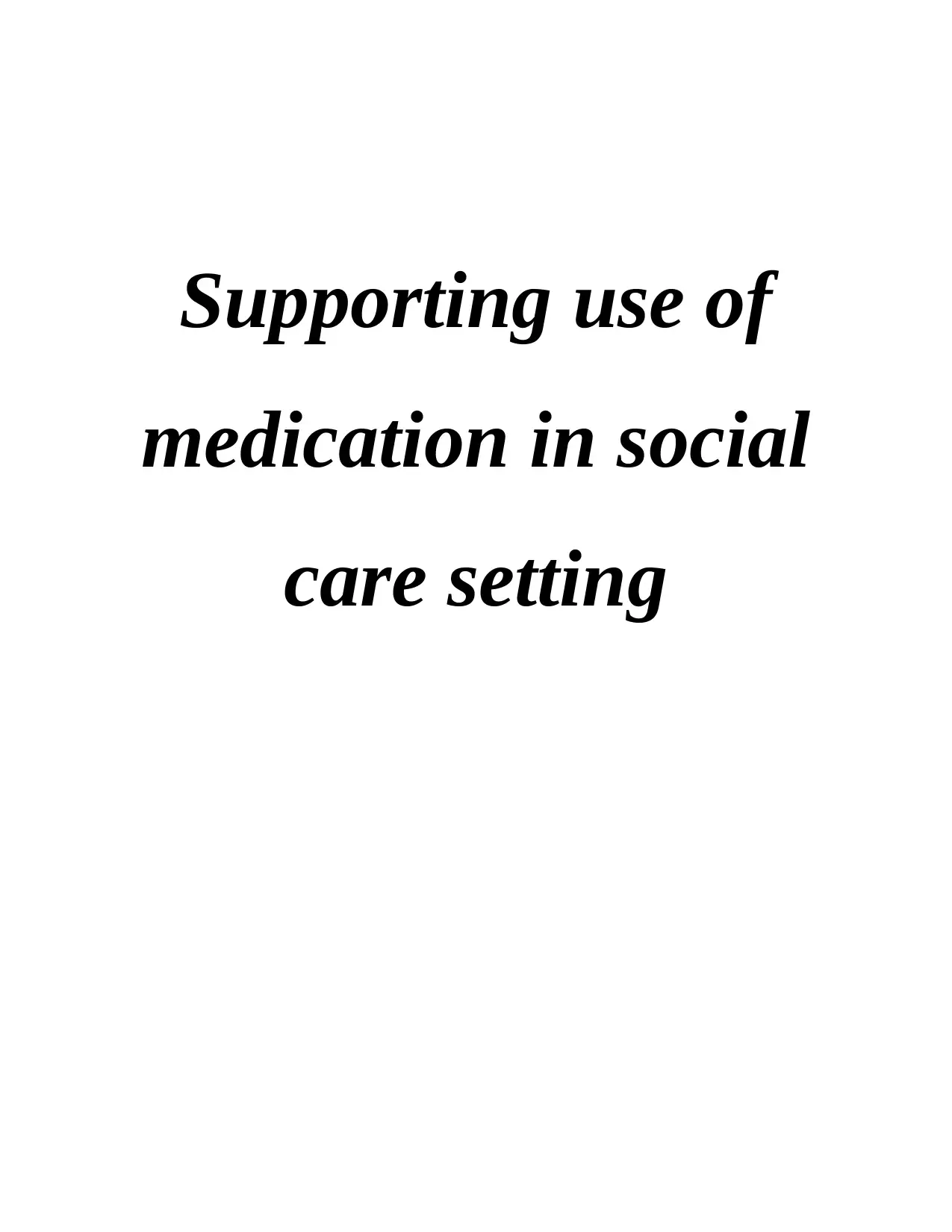
Supporting use of
medication in social
care setting
medication in social
care setting
Paraphrase This Document
Need a fresh take? Get an instant paraphrase of this document with our AI Paraphraser
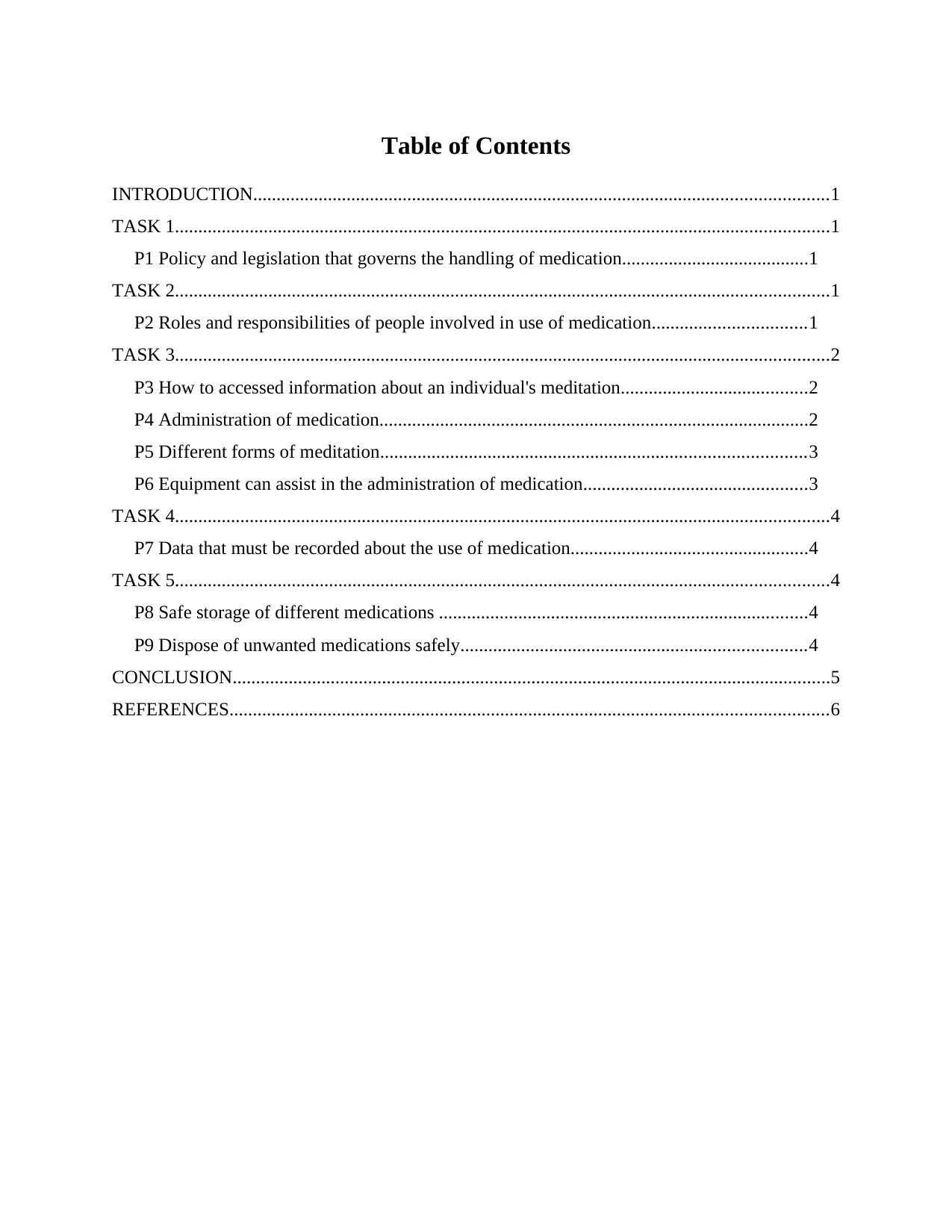
Table of Contents
INTRODUCTION...........................................................................................................................1
TASK 1............................................................................................................................................1
P1 Policy and legislation that governs the handling of medication........................................1
TASK 2............................................................................................................................................1
P2 Roles and responsibilities of people involved in use of medication.................................1
TASK 3............................................................................................................................................2
P3 How to accessed information about an individual's meditation........................................2
P4 Administration of medication............................................................................................2
P5 Different forms of meditation...........................................................................................3
P6 Equipment can assist in the administration of medication................................................3
TASK 4............................................................................................................................................4
P7 Data that must be recorded about the use of medication...................................................4
TASK 5............................................................................................................................................4
P8 Safe storage of different medications ...............................................................................4
P9 Dispose of unwanted medications safely..........................................................................4
CONCLUSION................................................................................................................................5
REFERENCES................................................................................................................................6
INTRODUCTION...........................................................................................................................1
TASK 1............................................................................................................................................1
P1 Policy and legislation that governs the handling of medication........................................1
TASK 2............................................................................................................................................1
P2 Roles and responsibilities of people involved in use of medication.................................1
TASK 3............................................................................................................................................2
P3 How to accessed information about an individual's meditation........................................2
P4 Administration of medication............................................................................................2
P5 Different forms of meditation...........................................................................................3
P6 Equipment can assist in the administration of medication................................................3
TASK 4............................................................................................................................................4
P7 Data that must be recorded about the use of medication...................................................4
TASK 5............................................................................................................................................4
P8 Safe storage of different medications ...............................................................................4
P9 Dispose of unwanted medications safely..........................................................................4
CONCLUSION................................................................................................................................5
REFERENCES................................................................................................................................6
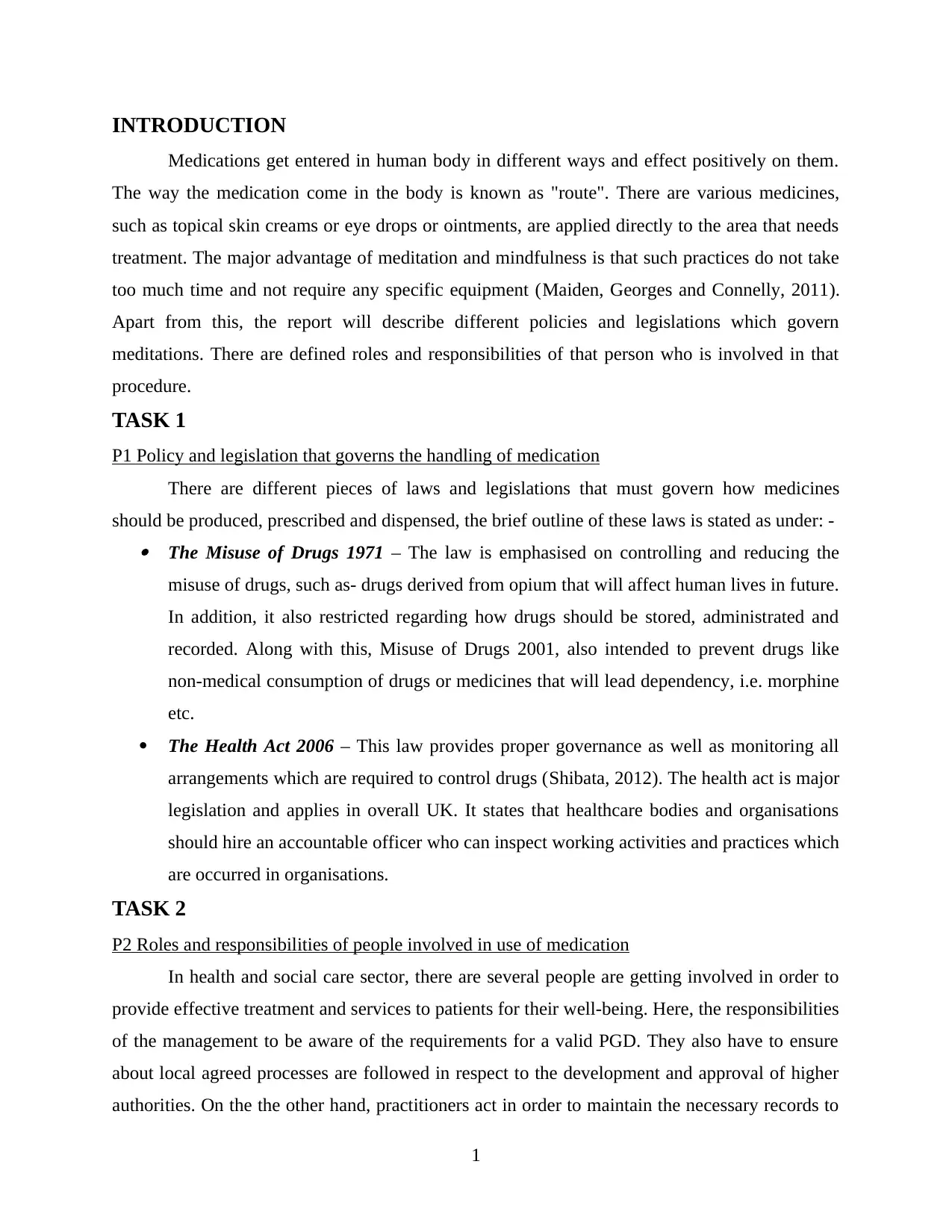
INTRODUCTION
Medications get entered in human body in different ways and effect positively on them.
The way the medication come in the body is known as "route". There are various medicines,
such as topical skin creams or eye drops or ointments, are applied directly to the area that needs
treatment. The major advantage of meditation and mindfulness is that such practices do not take
too much time and not require any specific equipment (Maiden, Georges and Connelly, 2011).
Apart from this, the report will describe different policies and legislations which govern
meditations. There are defined roles and responsibilities of that person who is involved in that
procedure.
TASK 1
P1 Policy and legislation that governs the handling of medication
There are different pieces of laws and legislations that must govern how medicines
should be produced, prescribed and dispensed, the brief outline of these laws is stated as under: - The Misuse of Drugs 1971 – The law is emphasised on controlling and reducing the
misuse of drugs, such as- drugs derived from opium that will affect human lives in future.
In addition, it also restricted regarding how drugs should be stored, administrated and
recorded. Along with this, Misuse of Drugs 2001, also intended to prevent drugs like
non-medical consumption of drugs or medicines that will lead dependency, i.e. morphine
etc.
The Health Act 2006 – This law provides proper governance as well as monitoring all
arrangements which are required to control drugs (Shibata, 2012). The health act is major
legislation and applies in overall UK. It states that healthcare bodies and organisations
should hire an accountable officer who can inspect working activities and practices which
are occurred in organisations.
TASK 2
P2 Roles and responsibilities of people involved in use of medication
In health and social care sector, there are several people are getting involved in order to
provide effective treatment and services to patients for their well-being. Here, the responsibilities
of the management to be aware of the requirements for a valid PGD. They also have to ensure
about local agreed processes are followed in respect to the development and approval of higher
authorities. On the the other hand, practitioners act in order to maintain the necessary records to
1
Medications get entered in human body in different ways and effect positively on them.
The way the medication come in the body is known as "route". There are various medicines,
such as topical skin creams or eye drops or ointments, are applied directly to the area that needs
treatment. The major advantage of meditation and mindfulness is that such practices do not take
too much time and not require any specific equipment (Maiden, Georges and Connelly, 2011).
Apart from this, the report will describe different policies and legislations which govern
meditations. There are defined roles and responsibilities of that person who is involved in that
procedure.
TASK 1
P1 Policy and legislation that governs the handling of medication
There are different pieces of laws and legislations that must govern how medicines
should be produced, prescribed and dispensed, the brief outline of these laws is stated as under: - The Misuse of Drugs 1971 – The law is emphasised on controlling and reducing the
misuse of drugs, such as- drugs derived from opium that will affect human lives in future.
In addition, it also restricted regarding how drugs should be stored, administrated and
recorded. Along with this, Misuse of Drugs 2001, also intended to prevent drugs like
non-medical consumption of drugs or medicines that will lead dependency, i.e. morphine
etc.
The Health Act 2006 – This law provides proper governance as well as monitoring all
arrangements which are required to control drugs (Shibata, 2012). The health act is major
legislation and applies in overall UK. It states that healthcare bodies and organisations
should hire an accountable officer who can inspect working activities and practices which
are occurred in organisations.
TASK 2
P2 Roles and responsibilities of people involved in use of medication
In health and social care sector, there are several people are getting involved in order to
provide effective treatment and services to patients for their well-being. Here, the responsibilities
of the management to be aware of the requirements for a valid PGD. They also have to ensure
about local agreed processes are followed in respect to the development and approval of higher
authorities. On the the other hand, practitioners act in order to maintain the necessary records to
1
⊘ This is a preview!⊘
Do you want full access?
Subscribe today to unlock all pages.

Trusted by 1+ million students worldwide
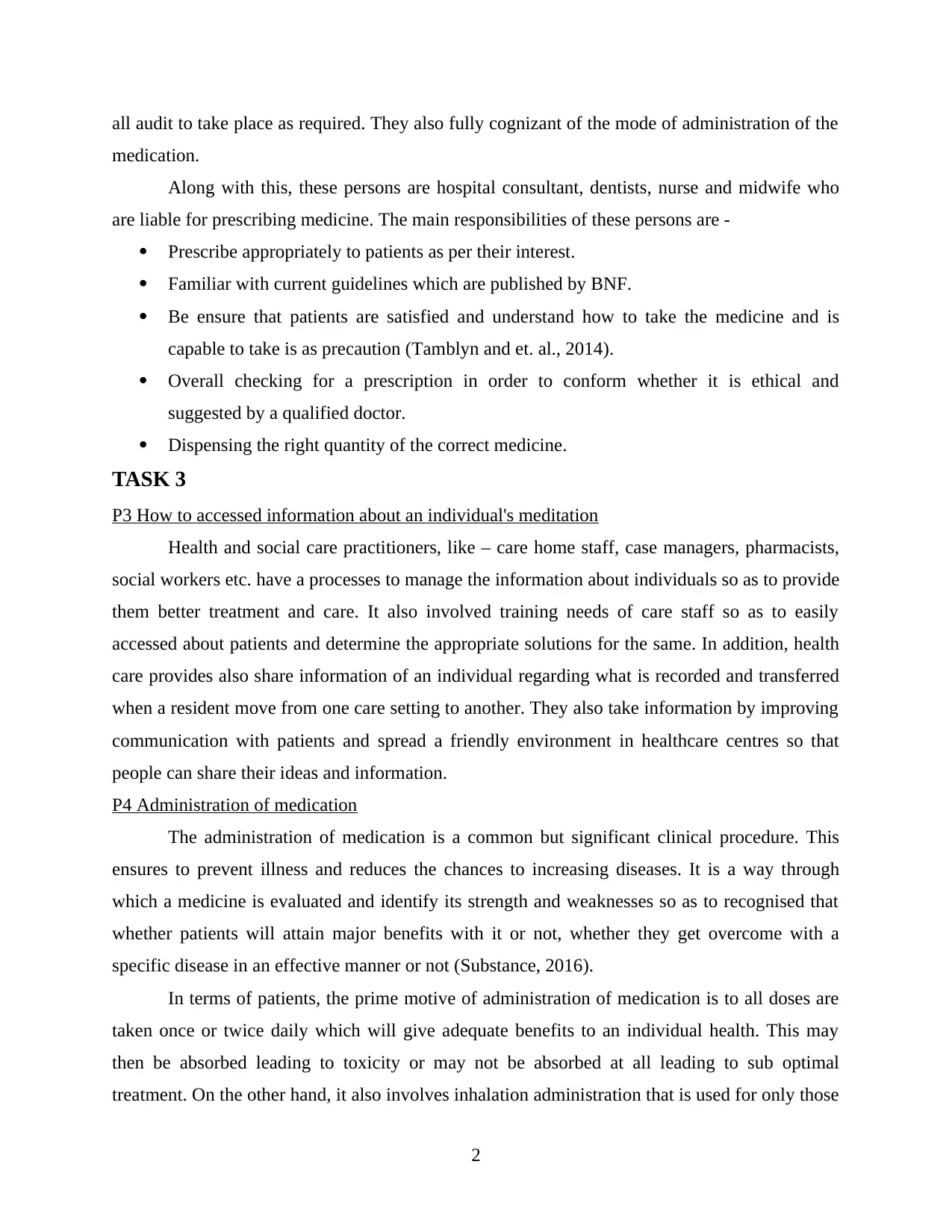
all audit to take place as required. They also fully cognizant of the mode of administration of the
medication.
Along with this, these persons are hospital consultant, dentists, nurse and midwife who
are liable for prescribing medicine. The main responsibilities of these persons are -
Prescribe appropriately to patients as per their interest.
Familiar with current guidelines which are published by BNF.
Be ensure that patients are satisfied and understand how to take the medicine and is
capable to take is as precaution (Tamblyn and et. al., 2014).
Overall checking for a prescription in order to conform whether it is ethical and
suggested by a qualified doctor.
Dispensing the right quantity of the correct medicine.
TASK 3
P3 How to accessed information about an individual's meditation
Health and social care practitioners, like – care home staff, case managers, pharmacists,
social workers etc. have a processes to manage the information about individuals so as to provide
them better treatment and care. It also involved training needs of care staff so as to easily
accessed about patients and determine the appropriate solutions for the same. In addition, health
care provides also share information of an individual regarding what is recorded and transferred
when a resident move from one care setting to another. They also take information by improving
communication with patients and spread a friendly environment in healthcare centres so that
people can share their ideas and information.
P4 Administration of medication
The administration of medication is a common but significant clinical procedure. This
ensures to prevent illness and reduces the chances to increasing diseases. It is a way through
which a medicine is evaluated and identify its strength and weaknesses so as to recognised that
whether patients will attain major benefits with it or not, whether they get overcome with a
specific disease in an effective manner or not (Substance, 2016).
In terms of patients, the prime motive of administration of medication is to all doses are
taken once or twice daily which will give adequate benefits to an individual health. This may
then be absorbed leading to toxicity or may not be absorbed at all leading to sub optimal
treatment. On the other hand, it also involves inhalation administration that is used for only those
2
medication.
Along with this, these persons are hospital consultant, dentists, nurse and midwife who
are liable for prescribing medicine. The main responsibilities of these persons are -
Prescribe appropriately to patients as per their interest.
Familiar with current guidelines which are published by BNF.
Be ensure that patients are satisfied and understand how to take the medicine and is
capable to take is as precaution (Tamblyn and et. al., 2014).
Overall checking for a prescription in order to conform whether it is ethical and
suggested by a qualified doctor.
Dispensing the right quantity of the correct medicine.
TASK 3
P3 How to accessed information about an individual's meditation
Health and social care practitioners, like – care home staff, case managers, pharmacists,
social workers etc. have a processes to manage the information about individuals so as to provide
them better treatment and care. It also involved training needs of care staff so as to easily
accessed about patients and determine the appropriate solutions for the same. In addition, health
care provides also share information of an individual regarding what is recorded and transferred
when a resident move from one care setting to another. They also take information by improving
communication with patients and spread a friendly environment in healthcare centres so that
people can share their ideas and information.
P4 Administration of medication
The administration of medication is a common but significant clinical procedure. This
ensures to prevent illness and reduces the chances to increasing diseases. It is a way through
which a medicine is evaluated and identify its strength and weaknesses so as to recognised that
whether patients will attain major benefits with it or not, whether they get overcome with a
specific disease in an effective manner or not (Substance, 2016).
In terms of patients, the prime motive of administration of medication is to all doses are
taken once or twice daily which will give adequate benefits to an individual health. This may
then be absorbed leading to toxicity or may not be absorbed at all leading to sub optimal
treatment. On the other hand, it also involves inhalation administration that is used for only those
2
Paraphrase This Document
Need a fresh take? Get an instant paraphrase of this document with our AI Paraphraser
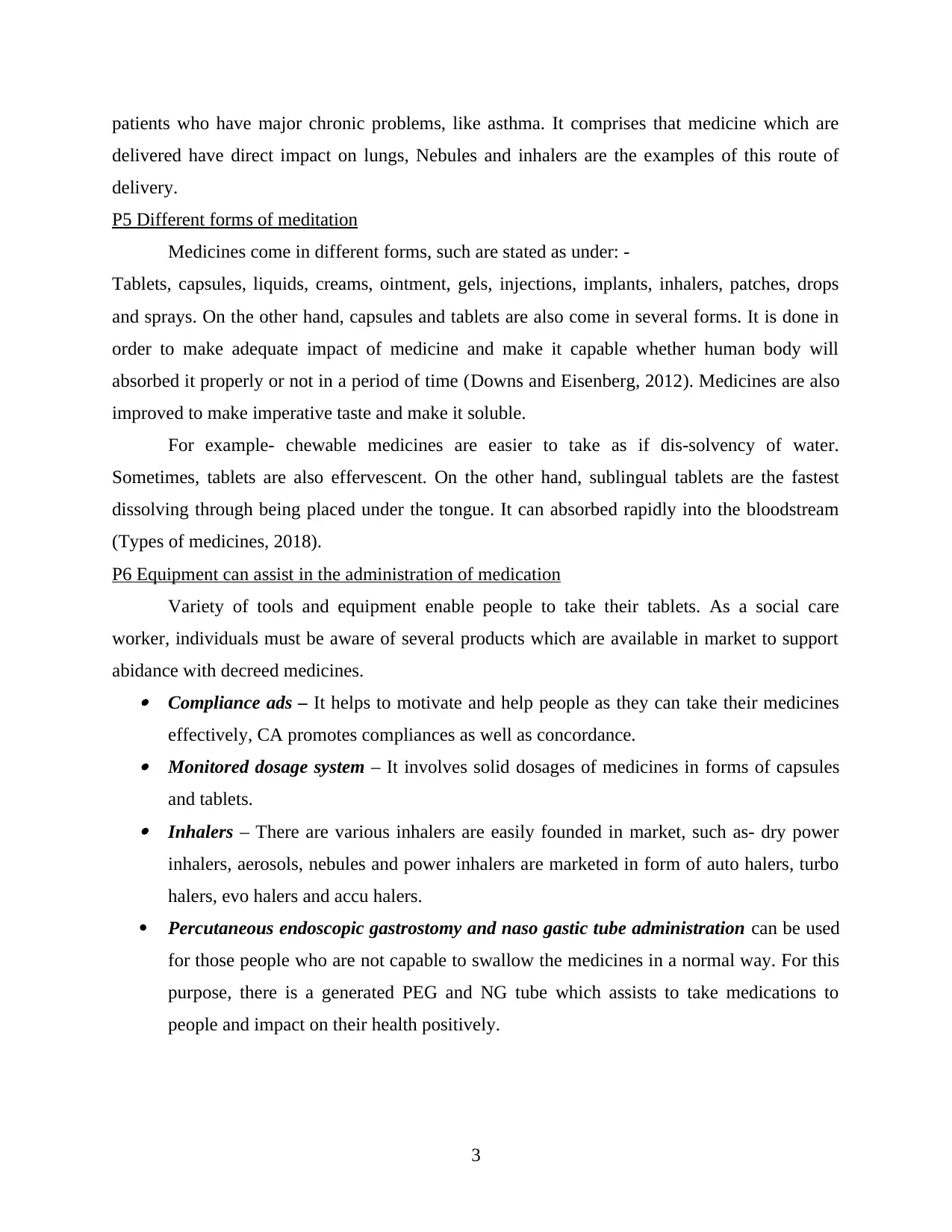
patients who have major chronic problems, like asthma. It comprises that medicine which are
delivered have direct impact on lungs, Nebules and inhalers are the examples of this route of
delivery.
P5 Different forms of meditation
Medicines come in different forms, such are stated as under: -
Tablets, capsules, liquids, creams, ointment, gels, injections, implants, inhalers, patches, drops
and sprays. On the other hand, capsules and tablets are also come in several forms. It is done in
order to make adequate impact of medicine and make it capable whether human body will
absorbed it properly or not in a period of time (Downs and Eisenberg, 2012). Medicines are also
improved to make imperative taste and make it soluble.
For example- chewable medicines are easier to take as if dis-solvency of water.
Sometimes, tablets are also effervescent. On the other hand, sublingual tablets are the fastest
dissolving through being placed under the tongue. It can absorbed rapidly into the bloodstream
(Types of medicines, 2018).
P6 Equipment can assist in the administration of medication
Variety of tools and equipment enable people to take their tablets. As a social care
worker, individuals must be aware of several products which are available in market to support
abidance with decreed medicines. Compliance ads – It helps to motivate and help people as they can take their medicines
effectively, CA promotes compliances as well as concordance. Monitored dosage system – It involves solid dosages of medicines in forms of capsules
and tablets. Inhalers – There are various inhalers are easily founded in market, such as- dry power
inhalers, aerosols, nebules and power inhalers are marketed in form of auto halers, turbo
halers, evo halers and accu halers.
Percutaneous endoscopic gastrostomy and naso gastic tube administration can be used
for those people who are not capable to swallow the medicines in a normal way. For this
purpose, there is a generated PEG and NG tube which assists to take medications to
people and impact on their health positively.
3
delivered have direct impact on lungs, Nebules and inhalers are the examples of this route of
delivery.
P5 Different forms of meditation
Medicines come in different forms, such are stated as under: -
Tablets, capsules, liquids, creams, ointment, gels, injections, implants, inhalers, patches, drops
and sprays. On the other hand, capsules and tablets are also come in several forms. It is done in
order to make adequate impact of medicine and make it capable whether human body will
absorbed it properly or not in a period of time (Downs and Eisenberg, 2012). Medicines are also
improved to make imperative taste and make it soluble.
For example- chewable medicines are easier to take as if dis-solvency of water.
Sometimes, tablets are also effervescent. On the other hand, sublingual tablets are the fastest
dissolving through being placed under the tongue. It can absorbed rapidly into the bloodstream
(Types of medicines, 2018).
P6 Equipment can assist in the administration of medication
Variety of tools and equipment enable people to take their tablets. As a social care
worker, individuals must be aware of several products which are available in market to support
abidance with decreed medicines. Compliance ads – It helps to motivate and help people as they can take their medicines
effectively, CA promotes compliances as well as concordance. Monitored dosage system – It involves solid dosages of medicines in forms of capsules
and tablets. Inhalers – There are various inhalers are easily founded in market, such as- dry power
inhalers, aerosols, nebules and power inhalers are marketed in form of auto halers, turbo
halers, evo halers and accu halers.
Percutaneous endoscopic gastrostomy and naso gastic tube administration can be used
for those people who are not capable to swallow the medicines in a normal way. For this
purpose, there is a generated PEG and NG tube which assists to take medications to
people and impact on their health positively.
3
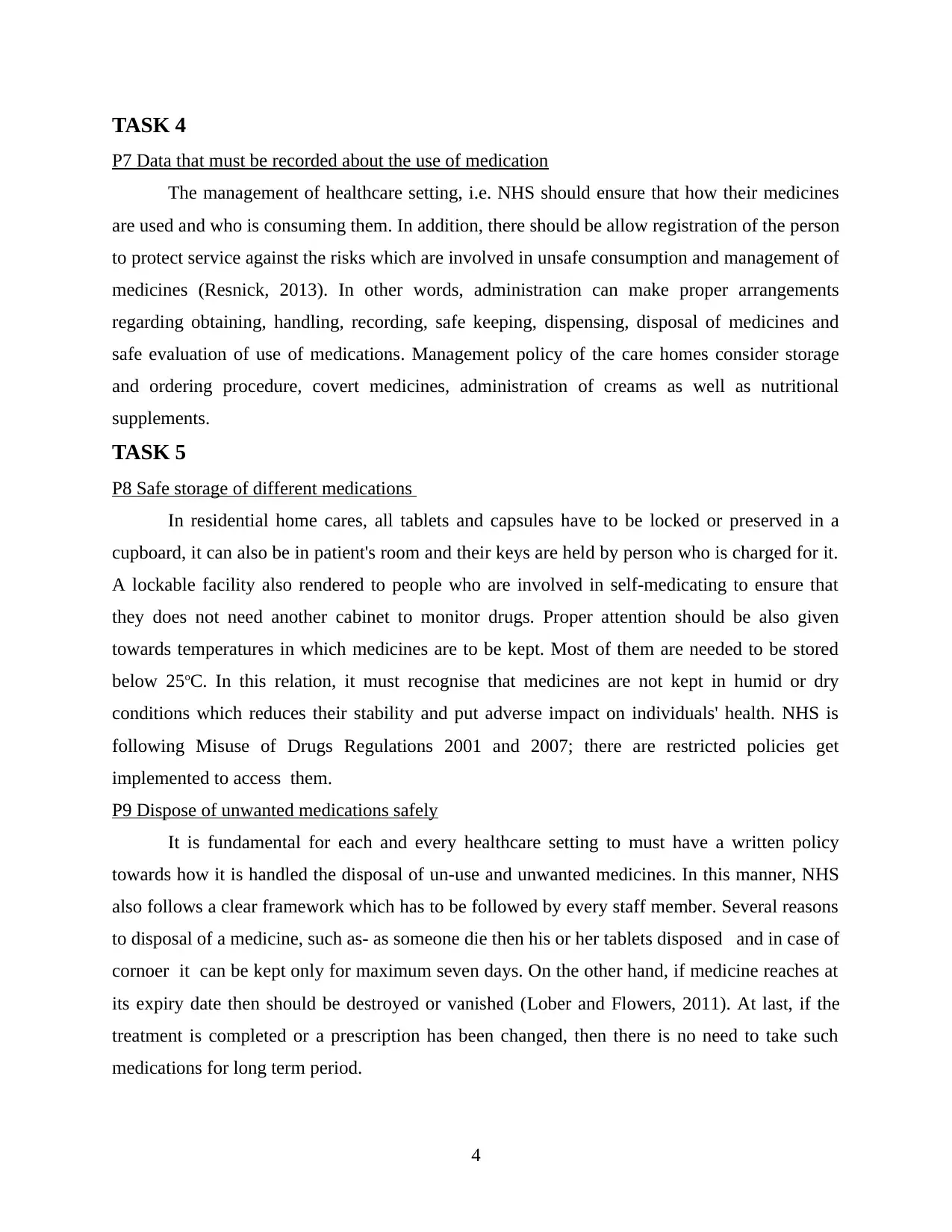
TASK 4
P7 Data that must be recorded about the use of medication
The management of healthcare setting, i.e. NHS should ensure that how their medicines
are used and who is consuming them. In addition, there should be allow registration of the person
to protect service against the risks which are involved in unsafe consumption and management of
medicines (Resnick, 2013). In other words, administration can make proper arrangements
regarding obtaining, handling, recording, safe keeping, dispensing, disposal of medicines and
safe evaluation of use of medications. Management policy of the care homes consider storage
and ordering procedure, covert medicines, administration of creams as well as nutritional
supplements.
TASK 5
P8 Safe storage of different medications
In residential home cares, all tablets and capsules have to be locked or preserved in a
cupboard, it can also be in patient's room and their keys are held by person who is charged for it.
A lockable facility also rendered to people who are involved in self-medicating to ensure that
they does not need another cabinet to monitor drugs. Proper attention should be also given
towards temperatures in which medicines are to be kept. Most of them are needed to be stored
below 25oC. In this relation, it must recognise that medicines are not kept in humid or dry
conditions which reduces their stability and put adverse impact on individuals' health. NHS is
following Misuse of Drugs Regulations 2001 and 2007; there are restricted policies get
implemented to access them.
P9 Dispose of unwanted medications safely
It is fundamental for each and every healthcare setting to must have a written policy
towards how it is handled the disposal of un-use and unwanted medicines. In this manner, NHS
also follows a clear framework which has to be followed by every staff member. Several reasons
to disposal of a medicine, such as- as someone die then his or her tablets disposed and in case of
cornoer it can be kept only for maximum seven days. On the other hand, if medicine reaches at
its expiry date then should be destroyed or vanished (Lober and Flowers, 2011). At last, if the
treatment is completed or a prescription has been changed, then there is no need to take such
medications for long term period.
4
P7 Data that must be recorded about the use of medication
The management of healthcare setting, i.e. NHS should ensure that how their medicines
are used and who is consuming them. In addition, there should be allow registration of the person
to protect service against the risks which are involved in unsafe consumption and management of
medicines (Resnick, 2013). In other words, administration can make proper arrangements
regarding obtaining, handling, recording, safe keeping, dispensing, disposal of medicines and
safe evaluation of use of medications. Management policy of the care homes consider storage
and ordering procedure, covert medicines, administration of creams as well as nutritional
supplements.
TASK 5
P8 Safe storage of different medications
In residential home cares, all tablets and capsules have to be locked or preserved in a
cupboard, it can also be in patient's room and their keys are held by person who is charged for it.
A lockable facility also rendered to people who are involved in self-medicating to ensure that
they does not need another cabinet to monitor drugs. Proper attention should be also given
towards temperatures in which medicines are to be kept. Most of them are needed to be stored
below 25oC. In this relation, it must recognise that medicines are not kept in humid or dry
conditions which reduces their stability and put adverse impact on individuals' health. NHS is
following Misuse of Drugs Regulations 2001 and 2007; there are restricted policies get
implemented to access them.
P9 Dispose of unwanted medications safely
It is fundamental for each and every healthcare setting to must have a written policy
towards how it is handled the disposal of un-use and unwanted medicines. In this manner, NHS
also follows a clear framework which has to be followed by every staff member. Several reasons
to disposal of a medicine, such as- as someone die then his or her tablets disposed and in case of
cornoer it can be kept only for maximum seven days. On the other hand, if medicine reaches at
its expiry date then should be destroyed or vanished (Lober and Flowers, 2011). At last, if the
treatment is completed or a prescription has been changed, then there is no need to take such
medications for long term period.
4
⊘ This is a preview!⊘
Do you want full access?
Subscribe today to unlock all pages.

Trusted by 1+ million students worldwide
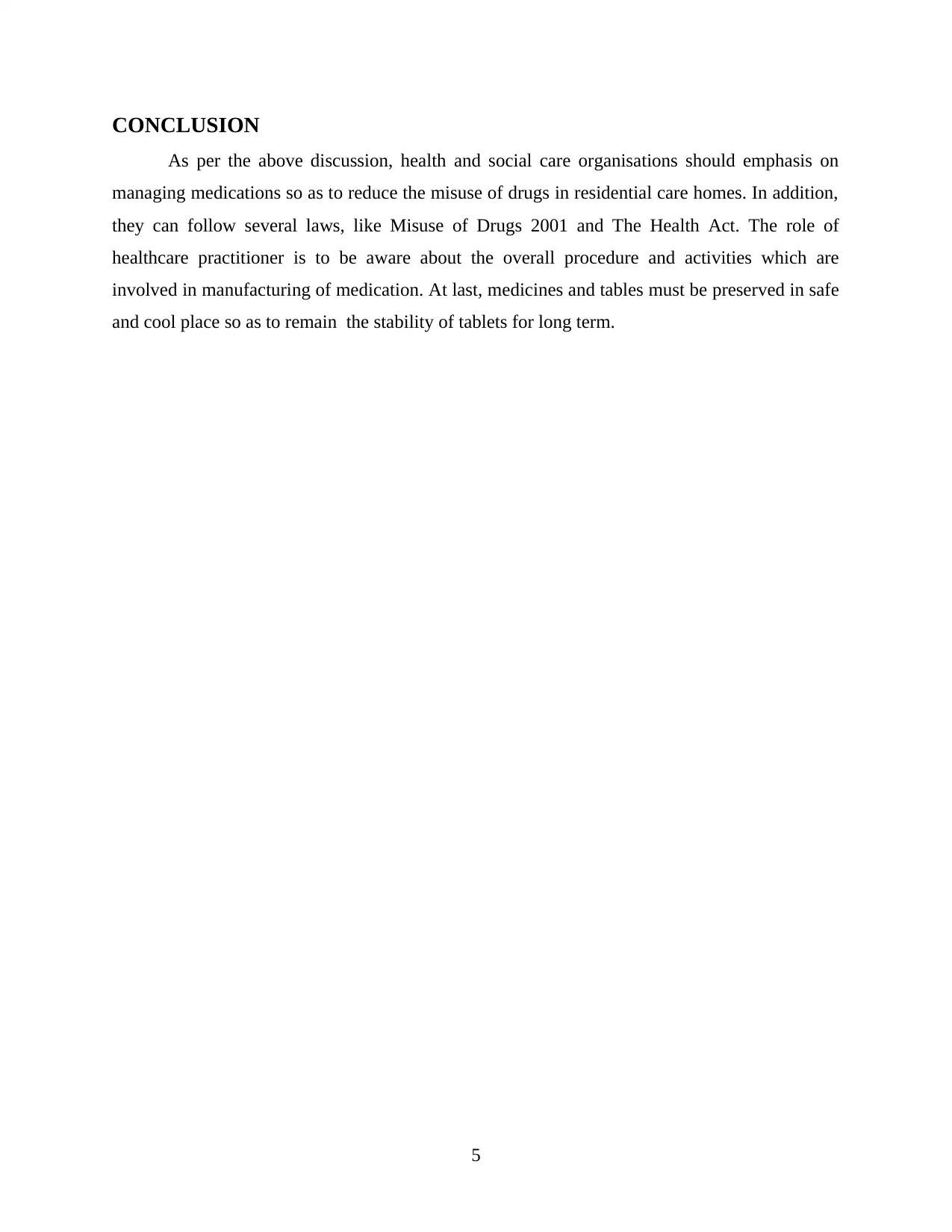
CONCLUSION
As per the above discussion, health and social care organisations should emphasis on
managing medications so as to reduce the misuse of drugs in residential care homes. In addition,
they can follow several laws, like Misuse of Drugs 2001 and The Health Act. The role of
healthcare practitioner is to be aware about the overall procedure and activities which are
involved in manufacturing of medication. At last, medicines and tables must be preserved in safe
and cool place so as to remain the stability of tablets for long term.
5
As per the above discussion, health and social care organisations should emphasis on
managing medications so as to reduce the misuse of drugs in residential care homes. In addition,
they can follow several laws, like Misuse of Drugs 2001 and The Health Act. The role of
healthcare practitioner is to be aware about the overall procedure and activities which are
involved in manufacturing of medication. At last, medicines and tables must be preserved in safe
and cool place so as to remain the stability of tablets for long term.
5
Paraphrase This Document
Need a fresh take? Get an instant paraphrase of this document with our AI Paraphraser
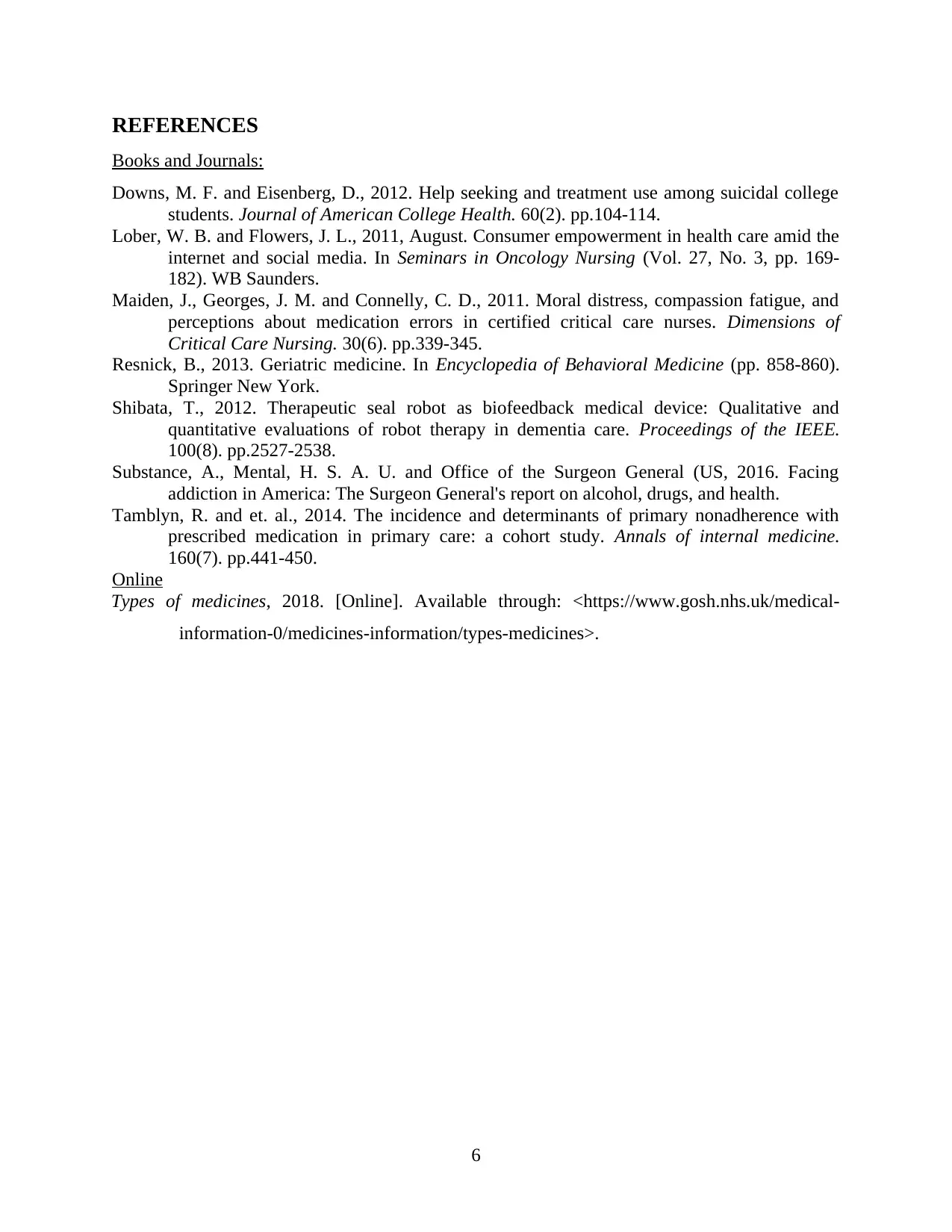
REFERENCES
Books and Journals:
Downs, M. F. and Eisenberg, D., 2012. Help seeking and treatment use among suicidal college
students. Journal of American College Health. 60(2). pp.104-114.
Lober, W. B. and Flowers, J. L., 2011, August. Consumer empowerment in health care amid the
internet and social media. In Seminars in Oncology Nursing (Vol. 27, No. 3, pp. 169-
182). WB Saunders.
Maiden, J., Georges, J. M. and Connelly, C. D., 2011. Moral distress, compassion fatigue, and
perceptions about medication errors in certified critical care nurses. Dimensions of
Critical Care Nursing. 30(6). pp.339-345.
Resnick, B., 2013. Geriatric medicine. In Encyclopedia of Behavioral Medicine (pp. 858-860).
Springer New York.
Shibata, T., 2012. Therapeutic seal robot as biofeedback medical device: Qualitative and
quantitative evaluations of robot therapy in dementia care. Proceedings of the IEEE.
100(8). pp.2527-2538.
Substance, A., Mental, H. S. A. U. and Office of the Surgeon General (US, 2016. Facing
addiction in America: The Surgeon General's report on alcohol, drugs, and health.
Tamblyn, R. and et. al., 2014. The incidence and determinants of primary nonadherence with
prescribed medication in primary care: a cohort study. Annals of internal medicine.
160(7). pp.441-450.
Online
Types of medicines, 2018. [Online]. Available through: <https://www.gosh.nhs.uk/medical-
information-0/medicines-information/types-medicines>.
6
Books and Journals:
Downs, M. F. and Eisenberg, D., 2012. Help seeking and treatment use among suicidal college
students. Journal of American College Health. 60(2). pp.104-114.
Lober, W. B. and Flowers, J. L., 2011, August. Consumer empowerment in health care amid the
internet and social media. In Seminars in Oncology Nursing (Vol. 27, No. 3, pp. 169-
182). WB Saunders.
Maiden, J., Georges, J. M. and Connelly, C. D., 2011. Moral distress, compassion fatigue, and
perceptions about medication errors in certified critical care nurses. Dimensions of
Critical Care Nursing. 30(6). pp.339-345.
Resnick, B., 2013. Geriatric medicine. In Encyclopedia of Behavioral Medicine (pp. 858-860).
Springer New York.
Shibata, T., 2012. Therapeutic seal robot as biofeedback medical device: Qualitative and
quantitative evaluations of robot therapy in dementia care. Proceedings of the IEEE.
100(8). pp.2527-2538.
Substance, A., Mental, H. S. A. U. and Office of the Surgeon General (US, 2016. Facing
addiction in America: The Surgeon General's report on alcohol, drugs, and health.
Tamblyn, R. and et. al., 2014. The incidence and determinants of primary nonadherence with
prescribed medication in primary care: a cohort study. Annals of internal medicine.
160(7). pp.441-450.
Online
Types of medicines, 2018. [Online]. Available through: <https://www.gosh.nhs.uk/medical-
information-0/medicines-information/types-medicines>.
6
1 out of 8
Related Documents
Your All-in-One AI-Powered Toolkit for Academic Success.
+13062052269
info@desklib.com
Available 24*7 on WhatsApp / Email
![[object Object]](/_next/static/media/star-bottom.7253800d.svg)
Unlock your academic potential
Copyright © 2020–2025 A2Z Services. All Rights Reserved. Developed and managed by ZUCOL.





